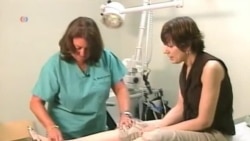The number of people around the world with peripheral artery disease, or PAD, has risen dramatically -- by almost 25 percent -- in just 10 years -- according to a new study in the Lancet medical journal. People with PAD have a higher risk of heart attack and stroke. They live with irreversible disability, and are likely to live in low or middle income countries.
Many people who have peripheral artery disease don't know they have it.
Researchers have found that stroke patients with PAD are three times as likely to have a second stroke, a heart attack, or die a few years after having the initial stroke.
PAD is a circulatory problem. It occurs when fatty deposits in the arteries restrict blood flow to the legs and feet.
The disease severely limits the ability to walk. Tissue can die, and gangrene can set in, requiring amputation.
Estimates suggest that PAD is increasing in every region of the world. Yet until now, there was no global study on its prevalence. The first one was just published in the Lancet medical journal.
Dr. Alan Hirsch wrote a comment on the study, conducted by researchers at the University of Edinburgh.
"No single study can answer the question of why PAD is so common and increasing in prevalence, but these authors and other research would suggest that it’s a combination of a wider exposure to the risk factors that cause artery blockages like smoking, high blood pressure, diabetes and [high] cholesterol," he explained.
But of all the risk factors, he said, one stands out. "Without a doubt the most important one is tobacco in all of its forms," he said.
The research shows that peripheral artery disease is expected to continue to rise dramatically, and that 70 percent of those who have PAD live in low or middle income countries, mainly in southeast Asia and the western Pacific regions.
Hirsch said the study should be a call to action for public health officials around the world to start education campaigns. "When a disease is this common, the answer is usually prevention, and prevention starts with an awareness of risk," he noted.
The key, he said, is to persuade people to give up bad habits. Hirsch said that for a pandemic already affecting a quarter of a billion people, local, national and international health officials have to start getting the word out now.
Many people who have peripheral artery disease don't know they have it.
Researchers have found that stroke patients with PAD are three times as likely to have a second stroke, a heart attack, or die a few years after having the initial stroke.
PAD is a circulatory problem. It occurs when fatty deposits in the arteries restrict blood flow to the legs and feet.
The disease severely limits the ability to walk. Tissue can die, and gangrene can set in, requiring amputation.
Estimates suggest that PAD is increasing in every region of the world. Yet until now, there was no global study on its prevalence. The first one was just published in the Lancet medical journal.
Dr. Alan Hirsch wrote a comment on the study, conducted by researchers at the University of Edinburgh.
"No single study can answer the question of why PAD is so common and increasing in prevalence, but these authors and other research would suggest that it’s a combination of a wider exposure to the risk factors that cause artery blockages like smoking, high blood pressure, diabetes and [high] cholesterol," he explained.
But of all the risk factors, he said, one stands out. "Without a doubt the most important one is tobacco in all of its forms," he said.
The research shows that peripheral artery disease is expected to continue to rise dramatically, and that 70 percent of those who have PAD live in low or middle income countries, mainly in southeast Asia and the western Pacific regions.
Hirsch said the study should be a call to action for public health officials around the world to start education campaigns. "When a disease is this common, the answer is usually prevention, and prevention starts with an awareness of risk," he noted.
The key, he said, is to persuade people to give up bad habits. Hirsch said that for a pandemic already affecting a quarter of a billion people, local, national and international health officials have to start getting the word out now.






